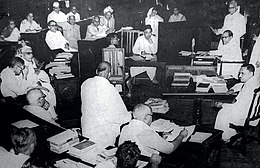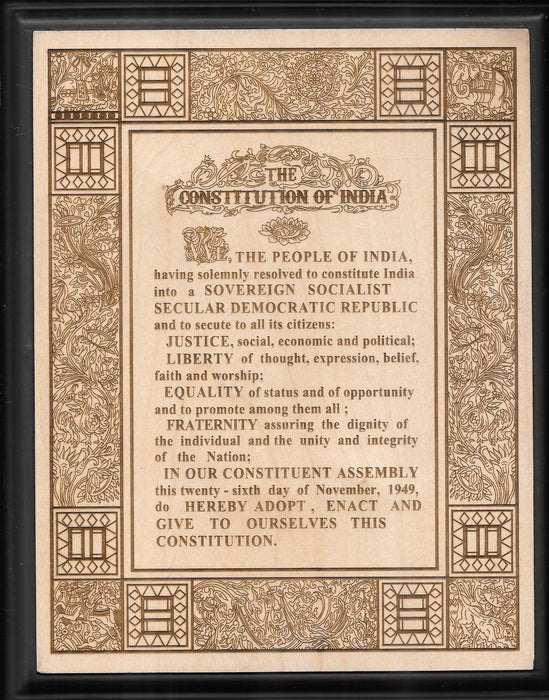Overview
On November 26 each year, India observes National Constitution Day, also known as ‘Samvidhan Divas,’ marking the meaningful adoption of the Indian Constitution in 1949 by the Constituent Assembly. This foundational document officially came into effect on January 26, 1950.

Recognising the significance of our constitutional framework, the Ministry of Social Justice and Empowerment took a noteworthy step on November 19, 2015. They declared November 26 as ‘National Constitution Day‘ to actively instill constitutional values among the citizens of India.
Let us now embark on a voyage through the annals of history, uncovering a few lesser-known facets that have sculpted the Indian Constitution, the cornerstone of the world’s largest democracy. Beyond the well-trodden paths of conventional narratives, we’ll delve into the intriguing details that paint a richer portrait of our constitutional heritage.
The Epic Journey of the Indian Constitution: A Chronicle

The Constitution of India, a monumental work and one of the lengthiest globally, emerged from the collective wisdom of the Constituent Assembly. Originally comprising 389 members, the assembly’s size transformed 299 post-India partition. Over a meticulous span of three years, the assembly dedicated eleven sessions spanning 165 days to carve out this constitutional masterpiece.
On December 9, 1946, the Constituent Assembly convened its inaugural session, marking the commencement of an arduous yet pivotal journey.
The momentous day arrived on November 26, 1949, when the Constitution of India was officially imbued with legal sanctity. However, the date of January 26 carries profound significance, having been chosen in 1930 to declare Purna Swaraj, symbolising complete freedom.

As the final strokes of this constitutional saga were painted on January 24, 1950, during the assembly’s concluding session, each member left an indelible mark by signing the Constitution twice – once in Hindi and once in English. This act sealed the culmination of an exhaustive drafting process and embraced linguistic diversity, echoing the essence of unity in India’s constitutional narrative.
The Indian Constitution – The Cornerstone that shaped the World’s Largest Democracy
A Document of Unrivalled Scope
The Constitution of India stands out globally as one of the most extensive and detailed governing documents. Comprising 448 articles, 12 schedules, and five appendices, it is a comprehensive manual addressing many subjects essential for the nation’s governance.
The World’s Longest Constitution
Crafting the final text of the Indian Constitution was no small feat—it unfolded over an extensive span of two years, eleven months, and eighteen days. This meticulous and time-consuming process contributed to the Indian Constitution’s distinction as the world’s longest, a testament to the thorough deliberations and dedication invested in shaping the nation’s foundational document.

A Handcrafted Masterpiece
The original copy of the Indian Constitution is a testament to meticulous craftsmanship. Handwritten precisely by the skilled calligrapher Prem Behari Narain Raizada, this labour of love took approximately six months to complete. Each page, not just a legal text but a work of art, features exquisite illustrations. The borders, a creation of the renowned modern Indian artist Nand Lal Bose, add a touch of artistic elegance to the entire document.
Preserving the Original Manuscript
The original manuscript of the Constitution was crafted on parchment sheets, each measuring an impressive 16X22 inches. Built to withstand the test of time, these sheets boast a lifespan of a thousand years and weigh 3.75 kilograms.

A Secure Haven: Library of Parliament of India
To safeguard this invaluable piece of history, the original manuscript finds its home in the Library of Parliament of India. To ensure optimal preservation, the document is stored in a specially designed helium-filled case within the confines of the library.
The Bag of Borrowings
Constitution of Britain:
- Parliamentary government
- Rule of Law
- Legislative procedure
- Single citizenship
- Cabinet system
Constitution of the United States Of America:
- Impeachment of the President
- Functions of President and vice-president
- Removal of Supreme Court and High Court judges
- Fundamental Rights
- Judicial review
Soviet Constitution of USSR (New Russia):
- Fundamental duties
- The Preamble expresses ideas of justice (social, economic, and political).
Constitution of Canada:
- Centrifugal form of federalism where the Centre is stronger than the states.
- Residuary powers vested with the Centre
- Centre appoints the Governors at the states
- Advisory jurisdiction of the Supreme Court
Constitution of Ireland:
- Directive Principles of State Policy
- Method of Election of the President
- Members’ nomination to the Rajya Sabha by the President
Constitution of France:
- Concept of “Republic”
- Ideals of Liberty, Equality, and Fraternity (contained in the Preamble)
Weimar Constitution of Germany:
- Suspension of Fundamental Rights during Emergency
Constitution of South Africa:
- Election of members of the Rajya Sabha
- Amendment of the Constitution
Constitution of Japan:
- Concept of “procedure established by Law”
This amalgamation of global influences reflects the rich tapestry of ideas that have contributed to the development of India’s constitutional landscape.
Preamble of the Indian Constitution

The Preamble of the Indian Constitution, a beacon of guiding principles, was scripted after the completion of the entire Constitution, encapsulating the essence of the nation’s aspirations. In a pivotal moment of transformation, the term ‘secular‘ was infused into the Preamble through the 42nd Constitutional Amendment Act of 1976, marking a defining chapter in India’s constitutional journey.
Total Expenditure
The Indian Constitution officially took charge with a total expenditure of ₹6.4 million.
From Dominion to Republic: A Paradigm Shift
At its very core, the Indian Constitution finds its roots in the Government of India Act 1935. As the Constitution seamlessly replaced the Government of India Act as the country’s fundamental governing document, the Dominion of India underwent a transformative rechristening, emerging proudly as the Republic of India.
Conclusion
In the tapestry of India’s democracy, the Constitution is a pillar of a thriving democracy. It is our shared responsibility as citizens to uphold the principles it embodies. As “We the People of India,” let us embrace our civic duties, ensuring the vibrant legacy of the world’s largest democracy.












Comments 3